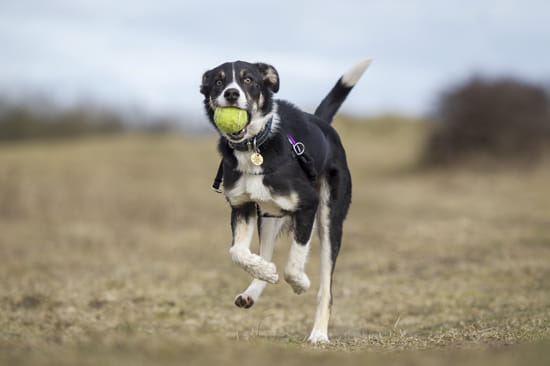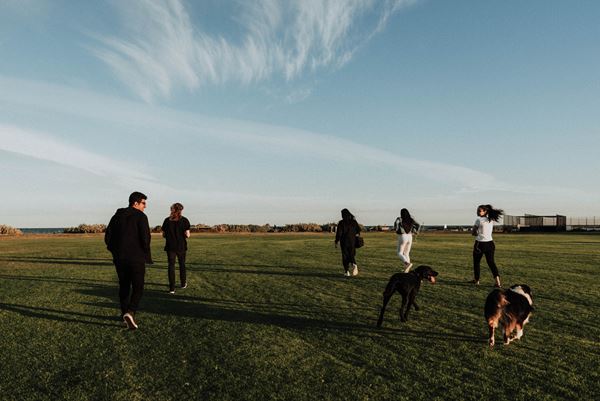Obesity isn’t just a problem for humans, but also dogs. The RSPCA has found that more than 40% of dogs are overweight or obese, which is a huge amount. A recent study by the University of NSW also found that more than half of owners didn’t walk their dog at all.
Knowing that our pets are following suit from human trends with obesity, why not take the opportunity to help ourselves and our four-legged companions, so let’s chat a bit about dog walking.
WHY SHOULD I TAKE MY DOG FOR A WALK? - 7 BENEFITS OF DOG WALKING
1. JOINT HEALTH
It might seem counterintuitive but going for walks can actually help your dog’s joints, even if they’re seniors. Regular walking can help keep joints working and functional. It’s a case of "use it or lose it". Nutritional support as well can make quite the impact, so finding a diet with glucosamine, chondroitin and Omega fatty acids is a great way to help aid their joint health.
2. WEIGHT MANAGEMENT
Any form of exercise will increase the amount of energy used each day, and a good walk definitely counts as well. It may seem obvious but it’s important to remember that to maintain a healthy weight, the amount of energy that we consume (and our pets as well) each day needs to match the energy that we use. If a walking pace is too easy or not quite keeping that extra weight at bay, try ramping up the pace to a light jog or a run. Walking is also a great way to maintain muscle mass without having to do intensive exercise.
3. DIGESTION & URINARY HEALTH
Walking is a good aid for digestion and can help your dog empty their bladder regularly. Infections can be more common if your dog isn’t able to relieve themselves regularly, so trips outside are a good way to keep their digestive and urinary system in a healthy cycle.

4. MENTAL HEALTH
Humans don’t usually stay at home all day and dogs shouldn’t have to either! Changing your dog’s environment can provide mental stimulation on an ongoing basis for them, but also yourself. The brain, just like other muscles, needs to be challenged regularly to develop. Walks are a perfect way to provide lots of new stimuli in the form of new sights, smells, sounds and tactile sensations. To really mix it up, try bringing them to different locations like dog-friendly parks, beaches, hikes and trail walks. You’ll probably enjoy being out and about just as much as they do!
5. SOCIALISATION
We all know at least one dog that is a bit socially awkward, making things difficult when they meet other dogs and people. Exposing your dog to different social environments during early stages of their development (9-12 weeks-old) is important to make sure they don’t miss out on normal behavioural development. Although leaving your dog to run around in a big garden could provide enough space for physical exercise, it won’t provide the social interactions they need.
- If your dog is up to date with vaccines, dog parks, group walks and dog-friendly beaches are great ways to normalize interactions with other dogs and humans.
- There are a lot of services that provide dog walking, or even better, dog adventures where they’ll take your dog on a dog-friendly adventure with a group of other dogs. This is a perfect solution if you’re time poor and really want to provide your dog with social opportunities and just tons of fun.
- Just like people, not all dogs are social beings so never force your dog to play with others. They may prefer to watch from the side-lines where they feel comfortable and just spend some quality time with their human.
6. BEHAVIOURAL
Going for walks also provides a great opportunity to practice obedience and training. It’s quite common to see dogs pulling at leashes, ignoring recall commands and chasing after things or people that would prefer to be left alone. Taking the time to properly train your dog to walk on a leash without pulling and to be responsive to recall commands will be appreciated by other people, dogs and general wildlife. If you can, start engraining these behaviours while your dog is still young. Practicing these commands at home where there are less distractions before taking them out into the real world is a great tip.
7. BOREDOM BUSTER
It should be no surprise that our dogs can get bored as well! Walking is a great way to burn off excess energy in dogs and help them vent any pent-up frustration that might result from boredom. Restlessness and boredom can take on lots of different forms: constant pestering, barking, excessive chewing, digging, escaping or a huge range of other more destructive behaviours. These are signs that they might need more avenues to use up energy. Daily walks are great for helping with this, exercising their mind and body through different stimuli. Burning their energy off during the day will also have the added effect of helping them rest better at night, hopefully helping you rest better at night too.
I’m Excited! Let’s do it! - HOW LONG SHOULD I WALK MY DOG?
If a dog could answer this question they might say “forever!”
It’s a great question and really depends on the breed of the dog, its age and if they have any health conditions that need to be considered. A senior dog with joint issues will need less exercise at a much lower intensity than a healthy adult border collie who is full of energy. However, walking regularly is a great low-impact option for them that can be tailored to each pet individually. A routine with regular exercise (e.g. a shorter walk each day) is preferable to one big walk in the weekend going for several hours.
Life can get in the way at times, and it can be difficult for some people with work or other commitments to dedicate time to a daily routine. Consider alternative options like including another family member, a friend or your local dog-walker, making sure your dog gets the opportunity to go outside.

THINGS TO MONITOR FOR WHEN GOING FOR WALKS
-
RISK OF OVERHEATING
-
Overheating can be real and even life-threatening for many dogs. Dogs cool down differently from humans and can succumb quickly to hot temperatures. Try to avoid walking during the hottest parts of the day. A pro tip is if the pavement is too hot to touch yourself, it’s too hot for your dog’s paws. During warmer weather, make sure you bring lots of water and try walk in the shade as much as you can. Brachycephalic (short snout) dogs like Pugs and French bulldogs should be extra careful as it is harder for them to manage their own body temperature and are therefore more susceptible to heat exhaustion.
-
-
OVERWEIGHT OR SENIOR DOGS
-
Walking is good for overweight and older dogs, but needs to be done in moderation and adjusted to their ability. If you have any questions about how much is too much, speak with your veterinarian. Don’t start intensive canine F45 challenges straight off the mark, but instead start with gentle, slow-paced walks and gradually increase the distance and difficulty as they become comfortable with each stage. Joint problems can also be a common problem for overweight or old dogs so make sure to feed a diet with joint or weight support.
-
-
RISK OF EATING THINGS THEY SHOULDN’T
-
Our dogs are fast, and their noses even faster! You never know what is under the hedge, in the drains, or around the corner. Especially when walking off-leash, supervise your dog to make sure they aren’t eating anything that is harmful to them (either toxic or that can cause a blockage). At the park, litter and food left by other people can be hazardous for dogs. Simple things like chocolate, raisins or grapes are common picnic foods but very dangerous for dogs. Beaches also pose a problem with jellyfish, dead animals and the dreaded fishing hook. With dog trails and beaches often being more remote, it can be difficult to find a nearby vet if things do go wrong.
-
-
FEEDING
-
Do you remember your parents telling you to wait 30 minutes before going for a swim? Make sure you give your dog time to digest their meals too. It’s recommended that you don’t feed a large meal immediately before or after exercise. In some cases, this can lead to medical concerns like bloat and other problems.
-
Getting out and walking with your dog is a great activity to keep you both fit and healthy, mentally and physically. Get outside and enjoy this time together.





